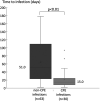Incidence and Time-to-Onset of Carbapenemase-Producing Enterobacterales (CPE) Infections in CPE Carriers: a Retrospective Cohort Study
- PMID: 36321906
- PMCID: PMC9769894
- DOI: 10.1128/spectrum.01868-22
Incidence and Time-to-Onset of Carbapenemase-Producing Enterobacterales (CPE) Infections in CPE Carriers: a Retrospective Cohort Study
Abstract
This study aimed to assess the proportion of carbapenemase-producing Enterobacterales (CPE) infections among all infectious episodes in CPE carriers, compare the time-to-onset of CPE infections with that of other infections, assess the mortality of patients with CPE infections, and identify risk factors for CPE infections in CPE carriers. A retrospective cohort study was performed over a 10-year period in our University Hospital, and 274 CPE carriers were identified. All infectious episodes within the first 6 months following the diagnosis of CPE rectal carriage were considered. Risk factor analysis for CPE infections in CPE carriers was performed by univariate and multivariate analyses. This study revealed an incidence of 24.1% (66/274) of CPE infection within 6 months of CPE carriage diagnosis. The 28-day all-cause mortality due to CPE infections was 25.7%. CPE infections represented 52.6% (70/133) of all infectious episodes in CPE carriers in the first 6 months following CPE carriage detection, and these significantly occurred earlier than non-CPE infections, with a median time of 15 versus 51 days, respectively (P < 0.01). Based on the multivariate analysis, prior neurological disease was the only risk factor associated with CPE infections in CPE carriers. CPE infections have an early onset, accounting for a large proportion of infections in CPE carriers, and are associated with high mortality. IMPORTANCE Carbapenemase-producing Enterobacterales (CPE) infections are emerging infections and may represent a therapeutic challenge, while effective antibiotic therapy is likely to be delayed. We aimed to assess the proportion of CPE infections in CPE carriers and to identify risk factors of CPE infections among this population that could guide empirical antibiotic therapy. We showed that CPE infections are frequent in CPE carriers, have an early onset after CPE carriage diagnosis, and represent a significant proportion of all infectious episodes in CPE carriers. No significant risk factors for CPE infections could be identified. Overall, this study suggests that empirical antibiotic treatment covering CPE might be initiated in CPE carriers at least in the first month after its diagnosis and in severe infections due to the high frequency and early occurrence of CPE infections in these patients.
Keywords: bacterial resistance; carbapenemase-producing Enterobacterales (CPE); mortality; rectal carriage; risk factors.
Conflict of interest statement
The authors declare no conflict of interest.
Figures
References
-
- Ruppé E, Armand-Lefèvre L, Estellat C, Consigny P-H, El Mniai A, Boussadia Y, Goujon C, Ralaimazava P, Campa P, Girard P-M, Wyplosz B, Vittecoq D, Bouchaud O, Le Loup G, Pialoux G, Perrier M, Wieder I, Moussa N, Esposito-Farèse M, Hoffmann I, Coignard B, Lucet J-C, Andremont A, Matheron S. 2015. High rate of acquisition but short duration of carriage of multidrug-resistant Enterobacteriaceae after travel to the tropics. Clin Infect Dis 61:593–600. doi:10.1093/cid/civ333. - DOI - PubMed
-
- Poole K, George R, Decraene V, Shankar K, Cawthorne J, Savage N, Welfare W, Dodgson A. 2016. Active case finding for carbapenemase-producing Enterobacteriaceae in a teaching hospital: prevalence and risk factors for colonization. J Hosp Infect 94:125–129. doi:10.1016/j.jhin.2016.06.019. - DOI - PubMed
-
- Lawandi A, Yek C, Kadri SS. 2022. IDSA guidance and ESCMID guidelines: complementary approaches toward a care standard for MDR Gram-negative infections. Clin Microbiol Infect. - PubMed
MeSH terms
Substances
LinkOut - more resources
Full Text Sources
Research Materials
Miscellaneous



